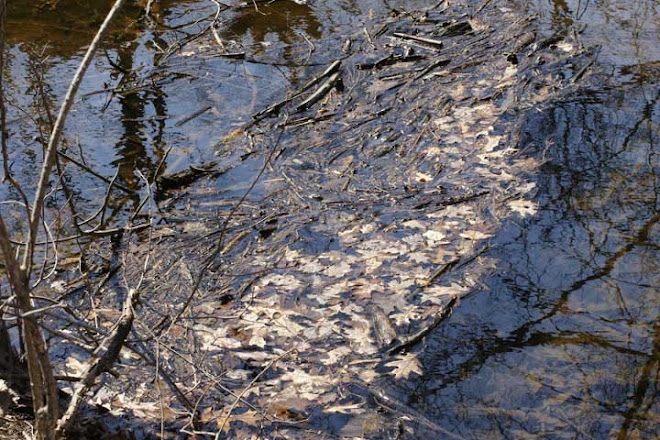As children, we mapped our world with creeks. We knew where they flowed—to the frog pond, into ditches beside the old railroad bed, north toward the Stillwater River. One ran all the way to the Mall. We followed them as far as we dared, walking alongside, wading in. Sometimes the banks were so slippery with viscous mud and clay that we could barely walk. We scooped up crawdads and tramped down stair-steps of sedimentary rock full of fossils. We knew where the vines were strong enough to swing out over the streambed. We knew which creeks ran all summer, and which ones were dry by late July, turned into reedy gullies at the edge of the cornfields. We knew where they ran fast (good for racing sticks) and we knew where they pooled around the fine red roots of the willow trees. We memorized their great stones, and their bars of gravel. We named the places near the water that held magic for us (Witches Lair, Glenwood, The Toy Fort, Warlock’s Will), but we did not name the creeks.
A mysterious series of fires around our area led to rumors that those who wouldn’t sell their land would be driven out. Then, there were bulldozers, massive earth-movers and backhoes leveling everything: they just plowed it all under. They knocked down farmhouses with the furniture still inside and trees that had stood for a century. We were still boys, and we got very excited by the thunderous power of those machines, which seemed like Mike Mulligan’s steam shovel on steroids. More often, though, we saw the workmen as our enemies, and we sat on the margins of the carnage mourning and bemoaning. They left no tree standing upright, and no sign of our subtle network of streams, just hard orange clay.
Once, a heavy rain hit, and the whole wasteland flooded. A temporary lake formed, four feet deep at the center. We dubbed it “Pond Superior,” in a burst of childish irony. We waded through it too, but it was featureless except for the name we gave it and the deep tread marks of the heavy equipment that we could feel with our feet. It was lifeless, full of muddy, brown, opaque water. Later, they gouged out a deep, straight ditch nearby, lined it with cement, and drained off the stagnant pool. For a time we scrambled over the eroding sides above the apron, building dams out of the clay for fun, trying to block the mini-gorges that formed. From this I learned definitively that nothing will stop water from finding its way down-hill.
Even in that stripped expanse, we children always sought the water, and knew instinctively that it was important to understand where it went, how it was all connected. When they laid the sewers and covered them over, we followed the streams underground, walking in the dark maze of pipes for what seemed like miles. We were following again the path of the flow, just a polluted trickle, among the raccoons and rats and cobwebs. This is a sad thing.
Our childhood stream-world was a paradise, a living web that included both our streams and our imaginations. I watched them bulldoze it, bury it, and encase it in concrete. I remember feeling that I had lost a friend. To this day, it is rather like a phantom limb, this thing that was part of me, that was severed.
There is an often remarked-upon naming practice whereby we call our housing developments and shopping malls after what was destroyed in order to build them. This is how unrelieved expanses of blacktop dotted with anonymous, air-conditioned boxes come to be called “Walnut Creek,” or “Greenbriar” or “Willowbrook Estates.” We name our “developments” after what used to be there, after what we have lost. It’s a last nod to the felt power of an actual place, and an attempt to convert that faint flash of recognition, that vestigial magic, into marketing. It’s an attempt to activate our sense of what we have been cut off from, to make us feel our phantom limb, and then to associate the ghostly tingling of remembered completeness with the knife that cut us.
“Development,” is a kind of name too, one that perpetrates a similar lie. “Development,” as it is currently practiced, is not the organic result of natural processes as the word (and its cousin term “growth”) insidiously suggests. “Development” is not inevitable and it is not usually necessary, no matter what insinuation the name might be asking you to accept. There is always another way.
We can have streams flowing through our towns, and in our backyards, with farms behind them. It is possible for us to live in places that are not all unnatural concentrations of near-identical houses, surrounded by close-cropped green-green-green fertilized faux-pastures, grass that no animal can safely walk on, let alone eat. In the place where I grew up, and all places like it (plats, subdivisions, suburbs) no one knows where the creeks go anymore. Or where they went. Or that there ever were any creeks there at all.
When we live like that, we are impoverished.
This is a sad thing.
Subscribe to:
Post Comments (Atom)




No comments:
Post a Comment